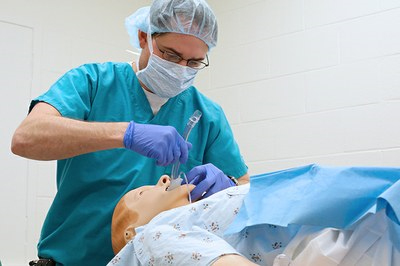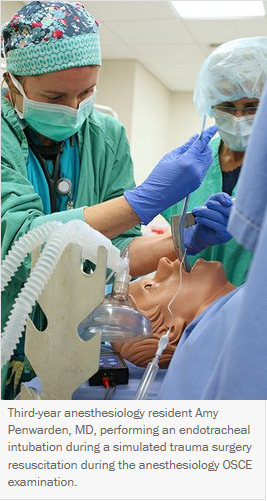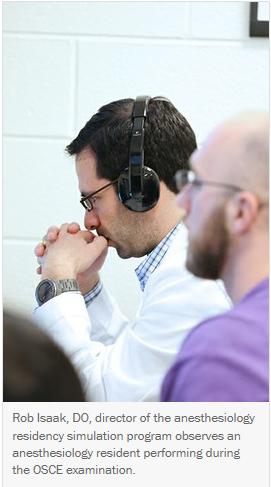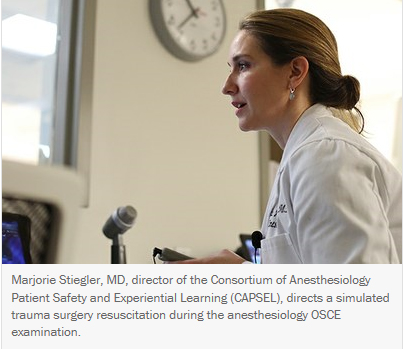Last month, the Department of Anesthesiology took simulation to a new level with a two-day, full-scale, high-fidelity training for residents that served two purposes: testing residents on a variety of competencies and preparing them for new accreditation standards and board certification processes.

Anesthesiology emergencies can quickly become life-threatening. Properly treating those emergencies requires facility with immediate response, quick judgment, and continual reevaluation of the medical scenario to be sure that treatment is effective. The Consortium of Anesthesiology Patient Safety and Experiential Learning (CAPSEL) in the Department of Anesthesiology at UNC leads anesthesiology resident training for such emergencies, using high-fidelity simulation that places residents in the real-life scenarios they may find in the operating room (OR).
“Our residents already understand medical management of emergencies and critical events,” says Marjorie Stiegler, MD, associate professor of anesthesiology at UNC and director of CAPSEL. “These trainings help them to practice and physically engage in the choreography of independently managing all kinds of events they may only rarely encounter in the OR during residency training.”
Last month, CAPSEL, in collaboration with the Department of Anesthesiology’s Clinical Competency Committee and Program Education Committee, created a new model for training anesthesiology residents that not only tests decision-making and other skills of second-, third-, and fourth-year residents, but also meets national accreditation requirements and prepares residents for the 2017 expansion of board examinations to include simulation.
Rob Isaak, DO, is assistant professor of anesthesiology, co-founder and assistant director of CAPSEL, and director of the anesthesiology residency simulation  program. He also designed last month’s training program and believes that the residents who participated are better prepared to advance in their education.
program. He also designed last month’s training program and believes that the residents who participated are better prepared to advance in their education.
“It’s incumbent on us to educate them not only on how to be an anesthesiologist, but also on how to pass the test for board certification,” says Isaak. “We believe that we’ve created a training model that may serve as a national model for resident education in anesthesiology.”
The training model responds to two specific assessment and certification changes. First, the Accreditation Council for Graduate Medical Education (ACGME) recently mandated that all anesthesiology residency programs evaluate their residents on 26 milestones – or different observable behaviors that document competency. More than a third of those milestones are to be assessed during simulation and reported back to ACGME.
 “During our training, we identified several of the ACGME milestone behaviors that would be difficult to observe in the operating room in a predictable manner,” explains Isaak. “For example, a resident needs to know how to competently manage an emergent situation to successfully achieve that particular milestone, but we could not reliably say that every resident was going to have an emergency to manage and be observed and assessed in that window. But we knew we could simulate it.”
“During our training, we identified several of the ACGME milestone behaviors that would be difficult to observe in the operating room in a predictable manner,” explains Isaak. “For example, a resident needs to know how to competently manage an emergent situation to successfully achieve that particular milestone, but we could not reliably say that every resident was going to have an emergency to manage and be observed and assessed in that window. But we knew we could simulate it.”
Second, the American Board of Anesthesiology (ABA) announced expansion of the certification process for residents. In addition to taking Part I (written) and Part II (oral) board exams, as required in previous years, future certification will include a Part II (APPLIED) exam, starting in 2017. Although the exact details of this exam are not yet available, it will consist of simulation and/or Objective Structured Clinical Examination-style (OSCE) encounters.
“An important part of what we’re doing is preparing our residents for that type of test,” says Stiegler. “Just as we practice mock oral exams with our trainees, we hope to make them comfortable and facile in an environment similar to what they’ll experience in the official ABA board exam, after they graduate.”
During the training, held in the new Clinical Skills and Patient Simulation Center facility in Berryhill Hall at the UNC School of Medicine, residents were presented with a variety of scenarios, written by Isaak, including facing limited resources in the OR because of a multiple trauma, encountering a difficult intubation necessitating a surgical airway, handling transfer of care, and having a challenging conversation with a patient. The scenarios incorporated a high-fidelity Laerdal manikin, task trainers, standardized patients, and confederates – actors playing roles such as nurse and physician – all while testing critical life-saving skills and asking residents to demonstrate patient- and family-centered care.
Third-year resident Kevin Powell, MD, appreciated the challenge of the training.
“The simulator/OSCE allows us to experience and learn from rare clinical scenarios, which will help us provide the absolute best patient care when these scenarios are encountered in real time,” says Powell. “Dr. Isaak and the team did a great job engineering a demanding OSCE experience, which I will definitely be able to use in my future patient encounters.”
The CAPSEL team promises to continue refining the training. One key research area for Isaak is whether live, in-person evaluations by faculty are necessary or if faculty can review behaviors of residents in these scenarios by video, on delayed playback. Traditionally, faculty members would need to be pulled out of their clinical assignments to evaluate residents in-person, creating scheduling complications and additional cost. Isaak received the Junior Faculty Develop Award from the UNC Executive Vice Chancellor & Provost’s Office to find out whether live, in-person or video-delayed assessments are more appropriate for performance assessment.
“There are benefits and drawbacks to each,” he says. “When you’re watching live you don’t have the ability to stop and rewind, but with delayed playback you don’t have the ability to change the camera angle or increase the volume or stop the scenario. If we find that evaluations are done with the same accuracy using both methods, we’ll be able to save costs of staffing the simulation with faculty. Evaluations could potentially be done after the simulations, at home, in between cases, whenever. It will become a lot less tricky from a scheduling perspective, and be a lot less costly.”
 Moving forward, CAPSEL expects to lead these trainings every six months because the milestones have to be assessed on that timetable and reported to ACGME. Isaak admits that he has only seen one or two programs in anesthesiology that are doing anything close to the scale being done by the UNC Department of Anesthesiology.
Moving forward, CAPSEL expects to lead these trainings every six months because the milestones have to be assessed on that timetable and reported to ACGME. Isaak admits that he has only seen one or two programs in anesthesiology that are doing anything close to the scale being done by the UNC Department of Anesthesiology.
“This program sets us apart from other residency programs since we’re directly training our residents to be successful in a required portion of their board exam, which will have a great impact on their ability to obtain licensure,” says Isaak. “Without the appropriate preparation, they may not perform as well, and we’re taking every step we can in order to train our residents so they’re most prepared both for the exam and the real world implications of these relatively common scenarios. This prepares them to manage those issues as they come up and identifies gaps in knowledge in decision-making capabilities.”
The response from residents has been positive.
“It was very well received by our residents,” says Stiegler. “While we’re serving a practical purpose for them professionally, the thing they love most about it is being given practice opportunities for independent management of life-threatening emergencies. Out in practice one day, it’s quite possible they will be the only anesthesiologist on-call one night. We need them to feel that they’ve had excellent training for these rare but serious emergencies. Through this training, they leave residency feeling that they’ve acquired a high degree of competence.”
by Zach Read – zachary.read@unchealth.unc.edu Photos by Max Englund – max.englund@unchealth.unc.edu